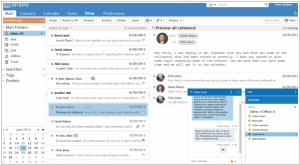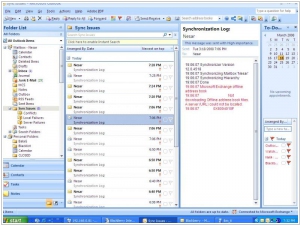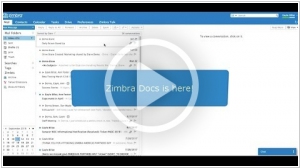Microsoft Exchange vs Zimbra
September 16, 2023 | Author: Adam Levine
17

Zimbra Collaboration Server is an email and calendar server plus much more; think about it like a next-generation Microsoft Exchange server. In addition to email and calendar, it provides file sharing, tasks, contacts, social media, document management and simplified administrative controls all in an award winning webmail user interface built with the latest AJAX web technology. ZCS also provides mobility and syncs to desktop client applications; the server is deployed on commodity Linux and Mac server hardware.
Microsoft Exchange and Zimbra are both popular email server platforms that offer comprehensive solutions for businesses and organizations. Microsoft Exchange, developed by Microsoft, is a widely recognized and widely adopted email and collaboration platform. It provides a robust set of features including email, calendar, contacts, tasks, and unified communication tools. With seamless integration with other Microsoft products and services, Exchange is known for its scalability, security, and extensive administrative controls. On the other hand, Zimbra is an open-source collaboration suite that combines email, calendar, contacts, and document sharing in one platform. It offers a web-based interface and supports integration with various productivity tools. Zimbra is favored by organizations looking for advanced customization options, flexibility, and high availability architecture.
See also: Top 10 Email services
See also: Top 10 Email services
Microsoft Exchange vs Zimbra in our news:
2019. Email collaboration software Zimbra added own document editors
Zimbra Network Edition has introduced an integrated, feature-rich office productivity suite called Zimbra Docs. The remarkable aspect is that it is available for free, eliminating the need for a separate MS Office license. With Zimbra Docs, users can now effortlessly create and edit documents, spreadsheets, and presentations directly within the Zimbra platform. It supports popular document formats such as xls, doc, ppt, and more. The suite includes various apps: Zimbra Writer for document editing, Zimbra Calc for spreadsheets, Zimbra Impress for presentations, and Zimbra Briefcase for converting and sharing files. At the core of this service is the Zimbra Docs server, which must be installed on dedicated nodes running RHEL 7 / CentOS 7, Ubuntu 16.04 LTS, or Ubuntu 18.04 LTS. In addition to its built-in office suite, Zimbra also offers integration with LibreOffice, providing users with another free office suite option.
2018. Microsoft released Exchange 2019, but no way to deploy it

Microsoft has recently launched a fresh iteration of its email and collaboration server, Exchange 2019. Although the update is available for download, there is a hindrance—installation is currently impossible. The reason being that it exclusively operates on the server operating system Windows Server 2019, which is yet to be released. In terms of Exchange 2019's innovations, they primarily revolve around enhancing system performance. The latest version has the capacity to utilize up to 48 processor cores and 256GB of RAM, with optimizations specifically tailored for SSD drives. It is evident (and Microsoft openly acknowledges this fact) that Exchange is being developed with a primary focus on large and exceedingly large enterprises. Consequently, Microsoft aims to transition small and medium-sized businesses to their cloud-based offering, Microsoft Office 365, which delivers email server functionality as a service.
2015. Synacor acquired Zimbra

The email and messaging software provider Zimbra, known for its open-source foundation, has been purchased by Synacor for a sum of $24.5 million. Synacor describes itself as a technology and monetization partner for video, internet, and communications providers, as well as device manufacturers and enterprises. According to Synacor officials, they intend to continue supporting the open-source version of Zimbra and provide technical assistance for Zimbra's Open Source Edition (OSE) through their value-added reseller (VAR) partners. Zimbra has previously been acquired by Telligent, VMware, and Yahoo. This recent acquisition comes shortly after the announcement that Verint has acquired Telligent (Zimbra Social) from Zimbra earlier in the week.
2010. Google Apps making Microsoft nervous

Recently, Google released the next anti-microsoft tool - Google Apps Migration for Microsoft Exchange, the plugin which allows you to easily move mail, calendars and contacts from Exchange to Google Apps. Last year they released the utility that syncs Outlook with Google Apps, but now you can import data directly from the Exchange server. Previously, Microsoft just ignored such events, or commented that Google Apps - is just a toy that no serious company will use. But Google's constant pressure is making them nervous. Microsoft recently launched the channel on Youtube, which contains videos explaining why MS Office products are better than Google's. For example, here's the video Exchange vs GMail: ***
2010. VMware buying Zimbra from Yahoo

What does this deal signify? For Yahoo, it marks the end of their involvement in the Enterprise game. The company will now focus on its consumer portal and will not interfere with its new strategic partner, Microsoft (because Zimbra is an MS Exchange competitor). For VMWare, this represents another significant step towards reaching the elite status in the Cloud Computing market. VMWare, being the largest developer of virtualization systems used in public and private cloud platforms, has recently acquired Springsource to create its own web platform as an alternative to Google App Engine. By acquiring the widely popular open-source collaboration suite Zimbra, VMWare gains the opportunity to enter the Web applications market. The exact sale price has not been disclosed yet, but it is likely lower than the $350 million paid by Yahoo in 2006.
2009. Exchange 2010 - unified messaging in the Cloud

Microsoft officially released the new version of its enterprise email server Exchange Server 2010. It's desktop client Outlook 2010 will appear only next year together with other Office 2010 applications. What is the most interesting about Exchange 2010? First, thanks to Windows Server 2008 R2 and Windows 7 (details here), and some new features in the new version, Exchange 2010 is now completely adopted for the cloud deployment. Of course, Hosted Exchange 2007 has been already provided for some years, but the latest version is much more secure, reliable and suitable for administration, when installed on the remote server (or in data-center). ***
2009. Yahoo released Zimbra Desktop 1.0
Zimbra Desktop 1.0, an email and collaboration client, has transitioned from its beta phase and is now available for free download. Zimbra sets itself apart from Outlook and Gmail by offering users both online and offline email functionality. Acting as a centralized hub for email, contacts, and calendar information, Zimbra allows users to access Yahoo and Gmail contacts, calendars, and messages within its platform, along with POP or IMAP email from providers like AOL, Hotmail, or office accounts. Although syncing with certain third-party email and calendar services in Zimbra Desktop is still considered beta, such as Hotmail, Yahoo, and Google calendars, this release has expanded support for these integrations. A Zimbra representative clarified that these integrations are labeled beta as they rely on APIs not maintained by the Zimbra team.
2008. How much does Exchange really cost?
A lively debate is unfolding in the comments section of an eWeek article by Clint Boulton, discussing Serena Software's decision to switch from Microsoft Exchange to Google Apps. The focus of the discussion revolves around the true cost of running Exchange. Serena claims that replacing Exchange with Google Apps will reduce their expenses from $1 million to $250,000 annually. Commenters question how an 800-employee company could spend such a substantial amount on email servers. This debate sheds light on how people evaluate the relative costs of on-premise software versus cloud-based alternatives. One commenter provides a breakdown of Exchange costs, while Serena's VP of corporate communications highlights the additional expenses associated with spam filtering, security, archiving, and disaster recovery. Despite the explanations, the discussion continues, with Exchange hosters suggesting they can offer equivalent services at a lower cost. The conversation underscores the ease with which the true cost of an on-premise application can be underestimated, including not only software and hardware expenses but also the often-overlooked costs of managing patches, upgrades, and user expectations. Serena's strategic commitment to becoming a SaaS vendor aligns with its interest in promoting the cloud narrative. However, the transition to Gmail may not be as abrupt as the eWeek story suggests, as Serena plans to continue using SharePoint for collaboration and may maintain Exchange until all users have migrated. Amidst the detailed arguments, the core message remains clear: Google Apps is significantly cheaper than Microsoft Exchange for corporate email systems, and those who argue otherwise underestimate the true costs of running Exchange on-premise.
2008. Zimbra Heads To The Cloud For Academic Institutions
Zimbra, the webmail and calendar company that was acquired by Yahoo in 2007, has introduced a new offering called Zimbra Hosted, specifically designed for academic institutions. This product enables schools to operate their webmail portals from the cloud, eliminating the need for on-site infrastructure or reliance on third-party hosting providers. By partnering with Zimbra and Yahoo, schools can now benefit from hassle-free server maintenance and operation. Zimbra is already serving more than 400 academic institutions, and earlier this year, it achieved a significant victory by being selected by Stanford as its email and calendar management system for students, surpassing competing services from Google and Microsoft Exchange. Zimbra's success can be attributed to its robust mobile support and enterprise-grade features.
2008. Yahoo Updates Calendar: Leverages Zimbra Technology
Yahoo has announced the closed beta launch of a major update to its online calendaring application, which will feature tighter integration with Yahoo Mail and other Yahoo services. The new calendar is built on the Zimbra platform, acquired by Yahoo in 2007, and supports iCalendar and CalDAV standards for interoperability with other calendaring services. Exciting new features include the ability to enhance calendars with Flickr photos, a built-in to-do list, and drag-and-drop support. Yahoo Calendar now also offers reminders via email, instant messaging, or SMS for important events. Furthermore, Yahoo is expanding sharing capabilities for groups to facilitate coordination. Initially, the new calendar will be available as a closed beta in select countries, with a gradual rollout planned for all Yahoo Mail users. Yahoo's VP for Yahoo Mail, John Kremer, emphasized the need for calendar redesign due to the increasing comfort and adoption of online calendaring and open standards. Yahoo aims to provide a cleaner, user-friendly interface with integrated features from Zimbra and plans to incorporate social aspects and content from other Yahoo properties in future updates. By leading the way in mainstream adoption of calendaring standards, Yahoo can shape the market and promote the use of open standards and online calendars.




